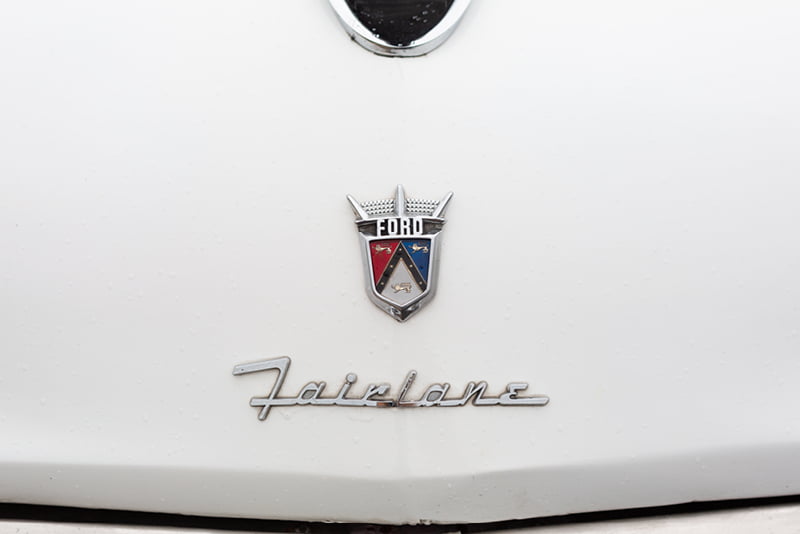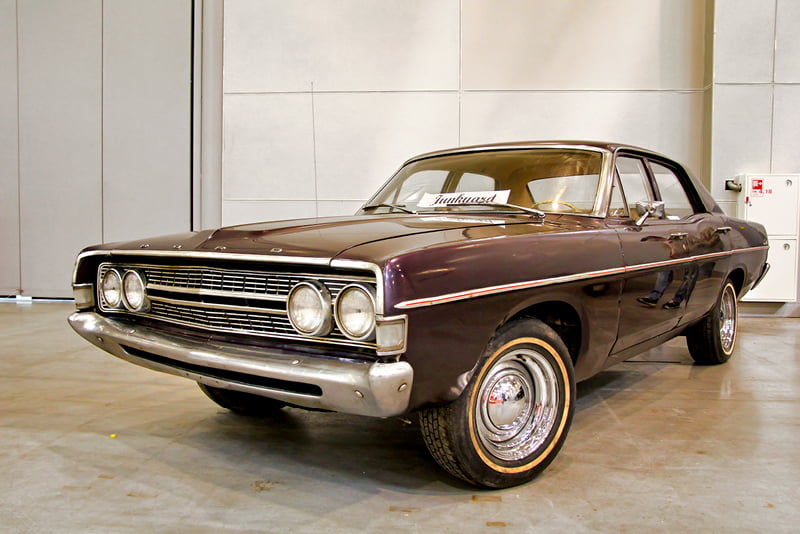Although regarded as one of the more underrated offerings from the American auto giant, there’s still plenty of surprising facts linked to the Ford Fairlane.
Before the era of the muscle car irrevocably changed the automotive landscape, the humble Ford Fairlane was one of those rare vintage cars that appealed to just about everyone. Big, comfortable and affordable, the Fairlane was first released in 1955 by the Ford Motor Company, and was purposefully designed to be an appealing sedan choice to the everyday American.
 Spanning seven generations across fifteen years of production, the American version of the Ford Fairlane replaced the Crestline as Ford’s full size automobile offering. Styled for the mid market in six body styles, the earlier generations are vastly different when compared to the later Australian versions that were incredibly popular throughout the seventies and eighties. With such a rich production history, even the biggest of Fairlane fans are still uncovering surprising pieces of information.
Spanning seven generations across fifteen years of production, the American version of the Ford Fairlane replaced the Crestline as Ford’s full size automobile offering. Styled for the mid market in six body styles, the earlier generations are vastly different when compared to the later Australian versions that were incredibly popular throughout the seventies and eighties. With such a rich production history, even the biggest of Fairlane fans are still uncovering surprising pieces of information.
Things You Didn’t Know About The Ford Fairlane
Through the years of its production, the American version of the Ford Fairlane was marketed in a wide variety of body styles, with just a handful of these including two-door and four-door sedans, two-door and four-door hardtops, station wagons, and both traditional and retractable-hardtop convertibles. At the time, it was supposed to feel as if there was a type of Fairlane for everyone.
Despite often being overlooked in favour of other offerings from the Ford Motor Company such as the Mustang and Thunderbird, the Fairlane’s evolution and legacy is arguably just as exciting.
What’s In A Name – The design team at Ford have come up with some pretty creative marketing strategies over the years, but the Fairlane’s badge is something extra special. As a nod to the vision behind the entire company, it was named after the estate of Henry Ford himself – “Fair Lane” located near Dearborn in Michigan.
It Helped Beat Chevrolet – Even the most devout “Blue Badge” fans are often surprised to learn that the second generation of Ford Fairlanes released in 1957 were ground-breaking in more ways than one. For the first time in twenty years, the Fairlane helped Ford outstrip their primary competitor Chevrolet in annual gross sales.
Rebranding Helped Sales – Although the Fairlane was still receiving quite healthy sales, the arrival of the Ford Galaxie saw the former get a demotion. Previously regarded as the top of the line offering from Ford, the Fairlane was bumped down to the mid market tier as a means to ensure the Galaxie was able to compete with the increasingly popular Bel Air.
Fairlanes Could Race – While not exactly regarded as the fastest of the Ford fleet, the Fairlane did have it’s moment in the spotlight in racing circles in 1964. The Ford Fairlane Thunderbolt was a limited edition drag racing version of the standard model, and its performance was enough for Ford to win the NHRA Super Stock Championship for the same year.
Size Did Matter – The earliest Fairlanes of the mid fifties were much like every other full size car on the market – big, brash, bold and marketed as the luxurious choice. However, third and fourth generation Fairlanes were reduced in size to better appeal to the mid size car market, before becoming a full size model once again in 1966.
The Australian Dream – While the Fairlane produced by Ford Motor Company in the United States was retired in 1970, Ford Australia was only just starting to manufacture our own homegrown versions. This new era of Fairlanes was a wild success with the Australian market, and remained in production all the way through to 2007.
 Classic car collectors are usually quite distinct in their preferences when it comes to obtaining a collectable Ford Fairlane, with the American version produced between 1955 and 1970 being favoured as the more valuable choice. However, getting your hands on one in Australia is no easy feat, so it’s always worth consulting with the professional to get an idea on tracking one down.
Classic car collectors are usually quite distinct in their preferences when it comes to obtaining a collectable Ford Fairlane, with the American version produced between 1955 and 1970 being favoured as the more valuable choice. However, getting your hands on one in Australia is no easy feat, so it’s always worth consulting with the professional to get an idea on tracking one down.
Getting Your Hands On A Classic Car
Meeting a fellow vintage auto enthusiast can feel a bit like finding a needle in a haystack, but rest assured that Classic’s Garage understands the thrill more than most. Having spent forty years collecting anything and everything from matchbox cars to hub caps, he’s successfully followed his passion to source, collect and stock beautiful and low mileage classic automobiles from around the world. With extensive experience in the automotive industry, it was only a matter of time before Wayne expanded on his love of vintage, iconic vehicles to share his knowledge and passion with the public.
Although his passion is for automobiles built before 1978, with a particular love for Buicks, Cadillacs, Lincolns, Oldsmobiles and even Fords, Wayne is just as passionate about the stories of the owners. Just like the cars, he has found that his fellow classic car enthusiasts all have wildly different attractions and logic behind their passion or hobby, and this often translates into how the car is presented. If it’s even remotely different, rare or just plain unusual, Wayne will overcome the relevant logistical and geographical challenges of bringing the cars to his showroom in Australia.
Classic’s Garage is a showroom conveniently located at Seventeen Mile Rocks, that specialises in the restoration and sales of vintage automobiles. In fact, he’s got a medley of fully restored models in stock right now, which can be viewed online via Wayne’s Collection. If you’re on the hunt for Brisbane classic cars – quite simply, Wayne is your man. If you would like to arrange a viewing or inspect any other of our classic vehicles, please get in touch with us today.

